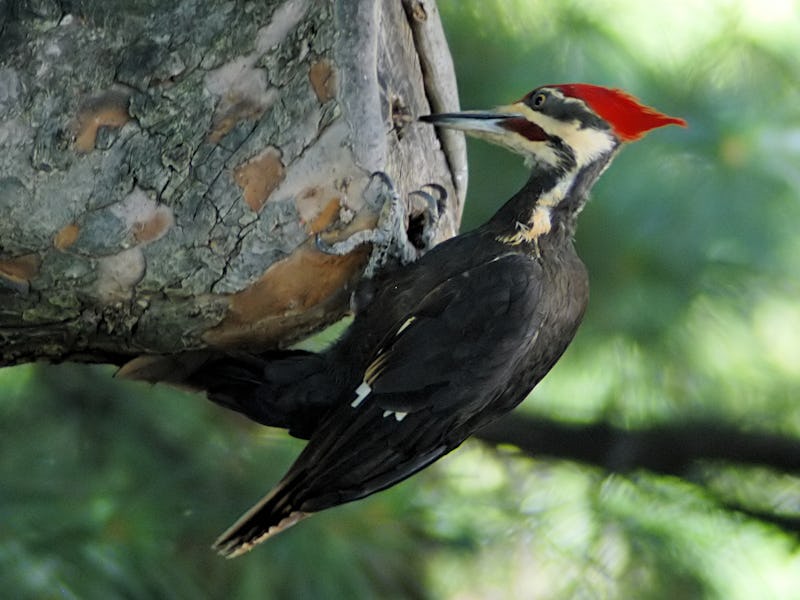What Woodpecker Brains Can Tell Us About Head Injuries in the NFL
A new study of woodpecker brains show what looks like brain damage, but the birds seem to be just fine.

Superbowl Sunday is expected to draw 110 million viewers tuning in to watch the big game — not including, just off the field, four independent concussion specialists strategically placed on the sidelines to quickly spot, evaluate, and treat potential head injuries that can lead to chronic traumatic encephalopathy, or CTE.
First diagnosed in an NFL player in the early 2000s, CTE has been the subject of a growing body of research on the degenerative condition.
On Friday, scientific journal PLOS ONE adds intriguing information in the growing field of research on CTE, although this one focuses not on football players, but rather on woodpeckers.
These hardy birds repeatedly bang their heads into wood with forces of 1200-1400 g (about ten times as much force as a football tackle that results in a concussion) when they are pecking wood — with no apparent brain damage.
At least, that’s what scientists have believed since an influential 1976 study. But because the study was based on an outdated brain-staining methodology, a team of researchers at Boston University decided to redo the research with modern technology.
Preserved woodpeckers used for this study.
The researchers, led by then BU graduate student George Farah, examined the preserved brains of ten woodpeckers of different species (six downy woodpeckers, one yellow-bellied sapsucker, one northern flicker, one pale-bellied woodpecker, and one lineated woodpecker) as well as a control group of the red-winged blackbird, which does not have a habit of banging its beak and head against anything.
This time around, the researchers found an abnormal buildup of the protein tau in the woodpeckers, but not in the non-pecking control group. In humans, comparable tau buildup would be an indication of brain damage. This throws into doubt the seminal results of the 1976 research that woodpeckers are not brain damaged.
According to researcher Peter Cummings, the team was surprised by the findings. “We didn’t think that we would find tau in the woodpeckers,” he tells Inverse. “From an evolutionary perspective, why would they have tau in the brains when they have been a species for thousands of years?”
Previously, researchers had believed that it was biophysical adaptations, including strong neck muscles and a long tongue that can brace the skull during the high impact pecking and hard bone towards the front of the skull (unlike birds’ usually lightweight, spongy skull, which is more aerodynamic).
But as Cummings wonders, “Why would the adaptations stop at the brain? You would think the brain itself would protect itself from impact.”
He also notes there are different types of tau, and that it is not necessarily pathologic. “Some are neuro-protective, and helps protect the neuron from becoming dysfunctional,” he says.
Of course, the scientists are quick to note that association is not causation, and that their findings require further research. Additionally, the scope of their project was limited, since the sample size was only fifteen birds, the ten woodpeckers and five blackbirds.
Woodpeckers are not the only animals that may be able to teach us more about CTE. Inverse has previously covered the lessons that zebrafish brains hold for brain injuries, while Farah says that they also considered studying the long-horned ram, which suffers similar head trauma during mating season.
Nevertheless, even the suggestion that the woodpeckers’ brains themselves may have evolved to accommodate regular head impact of such great force could provide further clues on how professional football players can continue to play America’s favorite sport — safely.
Abstract: Woodpeckers experience forces up to 1200–1400 g while pecking. It is assumed due to evolutionary adaptations, the woodpecker is immune to brain injury. This assumption has led to the use of the woodpecker as a model in the development of sports safety equipment such as football helmets. However, it is unknown at this time if the woodpecker brain develops neuro-trauma in relation to the high g-forces experienced during pecking. The brains of 10 ethanol preserved woodpeckers and 5 ethanol preserved red-winged black bird experimental controls were examined using Gallyas silver stain and anti-phospho-tau. The results demonstrated perivascular and white matter tract silver-positive deposits in eight out of the 10 woodpecker brains. The tau positive accumulations were seen in white matter tracts in 2 of the 3 woodpeckers examined. No staining was identified in control birds. The negative staining of controls birds contrasted with the diffuse positive staining woodpecker sections suggest the possibility that pecking may induce the accumulation of tau in the woodpecker brain. Further research is needed to better understand the relationship.